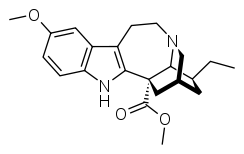Voacanga africana
Voacanga africana is a small tree in the family Apocynaceae, that grows to 6 m (20 ft) in height. It is native to tropical Africa. The small tree has leaves that are up to 30 cm (12 in) in length, and the tree produces yellow or white flowers, which after being successfully pollinated bear fruit with a green exocarp and yellow mesocarp surrounding the seeds. The fruit naturally splits in half when it is ripe.The alkaloids acts as CNS depressants and hypotensives [2]
| Voacanga africana | |
|---|---|
 | |
| Scientific classification | |
| Kingdom: | Plantae |
| Clade: | Tracheophytes |
| Clade: | Angiosperms |
| Clade: | Eudicots |
| Clade: | Asterids |
| Order: | Gentianales |
| Family: | Apocynaceae |
| Genus: | Voacanga |
| Species: | V. africana |
| Binomial name | |
| Voacanga africana | |
Description
Voacanga africana is a small tree up to 6 m (20 ft) tall with a spreading crown. The leaves are in opposite pairs, dark glossy green above and paler green below. The white flowers are in small bunches and either grow in the leaf axils or at the end of shoots. The fruits usually grow in pairs and are mottled green and spherical, with the seeds sunk in the yellow pulp.[3]
History
Voacanga africana was named by botanist Otto Stapf in 1894 after he received a type specimen from George Scott-Elliot, who had been participating in the Sierra Leone Boundary Commission.[4] From its discovery in 1894 onward, botanists considered the plant to have little economic usefulness apart from as a rubber adulterant.[5] This changed when, in 1955, French chemists Maurice Marie-Janot and Robert Goutarel extracted three alkaloids from the Voacanga africana which they believed could be used in the treatment of heart conditions.[6] Global interest in the plant as a source of useful chemicals followed, and today the plant is a major non-timber forest product exported from Ghana, Cameroon, and Nigeria, and Cote d'Ivoire.[7].
Uses


The plant contains a large number of alkaloids related to the anti-addiction medication ibogaine, including some of the only known naturally occurring CB1 receptor antagonists.[8] One of the plant's alkaloids, voacangine, has been used as a precursor in the semi-synthesis of ibogaine. [9] While small amounts of ibogaine are found in Voacanga Africana root bark, they do not occur in sufficient quantity to have medicinal or psychoactive effects. Extracts from the plant are also used in the production of vinpocetine, a medication used to treat Alzheimer's disease, and vinblastine, used to treat leukemia.[10][11]
The 1998 Encyclopedia of Psychoactive Plants by Christian Rätsch included an entry on the Voacanga genus, which claimed that various members of the genus are used in West Africa for their psychoactive effects.[12] Since 2007, more specific, unsubstantiated rumors have circulated that the bark and seeds of the tree are used in Ghana as a poison, stimulant, and ceremonial psychedelic due to an edit made to a Wikipedia article about the plant by a Ghanaian businessman who linked to a website advertising the seeds.[7] A 2009 study by the National Institute of Health Sciences in Tokyo, Japan found that the Voacanga africana seed products sold online consisted of a mix of chemically distinct products[13].
References
- "Voacanga africana". Germplasm Resources Information Network (GRIN). Agricultural Research Service (ARS), United States Department of Agriculture (USDA). Retrieved 2008-04-05.
- "Leeuwenberg et al Agric. Univ. Wagenigen papers". Retrieved July 7. Check date values in:
|access-date=(help) - Maurice M. Iwu (2014). Handbook of African Medicinal Plants. CRC Press. p. 330. ISBN 978-1-4665-7198-3.
- Elliot, G. F. Scott (February 1, 1894). "On the Botanical Results of the Sierra Leone Boundary Commission". Botanical Journal of the Linnean Society. 30 (206): 64–100. doi:10.1111/j.1095-8339.1894.tb02390.x – via academic.oup.com.
- Frederick R. Irvine, Woody Plants of Ghana: With Special Reference to their Uses, Oxford University Press, 1961.
- "New alkaloids".
- "The Invention of Voacanga africana as a Ceremonial Psychedelic | Environment & Society Portal". www.environmentandsociety.org.
- Al-Harrassi, Ahmed, Ivan R. Green, Javid Hussain, and Hidayat Hussain. “Chemistry and biology of the genus Voacanga”, Pharmaceutical Biology, New York and London: Informa Healthcare USA, 2012.
- "Voacanga Ibogaine Production Guide". August 28, 2015.
- "Voacanga Africana - tropical native tree of Africa - Covex". www.covex.com.
- "Voacanga africana (PROTA) - PlantUse English". uses.plantnet-project.org.
- The Encyclopedia of Psychoactive Plants: Ethnopharmacology and its Applications by Christian Rätsch, 341-342
- Kikura-Hanajiri, R.; Maruyama, T.; Miyashita, A.; Goda, Y. (2009). "Chemical and DNA analyses for the products of a psychoactive plant, Voacanga africana". Yakugaku Zasshi. 129 (8): 975–82. doi:10.1248/yakushi.129.975. PMID 19652504.